- Home
- David R. George III
Sacraments of Fire Page 11
Sacraments of Fire Read online
Page 11
In the darkness, Nog shook his head, frustrated by his inability to sleep—or really to do much of anything besides work. Earlier that evening, after beta shift, he had actually forced himself to visit the Plaza. He thought he might benefit from being around people in a social setting. He went to his Uncle Quark’s place, where he found several of his crewmates among the multitudes of newly arrived civilians, but he quickly discovered that he could find no enthusiasm for socializing with his friends—people who, even if they didn’t mention it or show it, suffered in the same way that he did.
More than anything, Nog wanted to spend some time with Vic Fontaine. Since the destruction of the original Deep Space 9, the holographic character and his program had remained active, but inaccessible. Nog’s uncle saved Vic by placing his holoprogram in a simulation tester prior to abandoning the station, but he then had to leave the singer in the device for the two years it took to construct the new DS9. The business Quark established on Bajor at first lacked holosuites, and when he finally did have some installed, the older models he purchased did not have the capacity to host Vic’s complex matrix. The facilities on the new starbase did, but interface issues had so far prevented the program from a successful transfer out of the simulator. Quark had repeatedly requested assistance from DS9’s engineers—including Nog—but the crew had been too busy with the transition of the starbase to full operational status to work on the issue. Vic’s program continued to execute in the tester, where it advanced in real time, but without any interaction with flesh-and-blood people.
If the program hasn’t failed, Nog thought morosely, and if Vic’s matrix hasn’t degraded. In the best-case scenario, the life of Vic Fontaine had proceeded without any external input, but any manner of software or hardware failure could have effectively ended that life. Even if the program could be made to run again, Vic Fontaine might appear as an empty shell, with all of the memories and personality traits formed out of his experiences on the old Deep Space 9 lost forever. In truth, Nog had no idea what he would find once Vic’s program was returned to a holosuite.
“But I’m going to find out,” he decided. A rush of intensity overcame him that seemed equal parts enthusiasm at the prospect of seeing his old friend, and refusal to deal with his troubled emotions. He didn’t care. He threw off the bedclothes, jumped to his feet, and started to dress.
NOG KNEELED ON THE DECK of the holosuite, the simulation tester beside him. An optical data network cable ran from where he had removed an access panel on the bulkhead to the portable device—a gray metal cube, mounted on one corner atop a black base, with indicator lights, as well as input slots for four isolinear optical rods, one of which was filled. He leaned forward and pressed his face up close to the circuitry inside the bulkhead. He studied the architecture of the interface, then read through the numbers on the screen of his engineering tricorder. He saw nothing that didn’t add up—no out-of-bounds tolerances, no potential for feedback, no failed or failing components.
“This should work,” Nog told himself. The confusion he heard in his own voice accurately reflected his frame of mind.
Nog had arrived at his uncle’s bar around zero-two-thirty. By that time, the crowds of customers he’d seen earlier had begun to thin. Nog offered to work on uploading Vic Fontaine’s program. Despite having three unoccupied holosuites at the time, Quark objected, demanding that he come back at zero-four-hundred, arguing that, despite the lateness of the hour, he still hoped some other paying customers might want holo-experiences that night.
Nog had argued right back, even going so far as to quote the 108th Rule of Acquisition: Hope doesn’t keep the lights on. He also threatened not to return at all, on that night or any other. Quark relented.
That had been ninety minutes earlier—ninety minutes in which Nog had made absolutely no progress. Before he started, he noticed that the maintenance logs indicated that somebody had been working on the problem. Nog wondered who on his uncle’s staff might be capable of doing so, but he couldn’t come up with a name. It concerned him, though, because somebody who didn’t really know what they were doing could actually end up permanently damaging Vic’s matrix before they managed to upload it. He would have to warn Quark about that.
Nog had begun his own efforts by attempting to upload Bashir 62—Vic’s program—into the holosuite buffers. He did not succeed. He expected that, since it had been tried several times before, but he wanted to monitor the upload malfunction in order to understand exactly where the process broke down. Once that became clear, he believed he would be able to isolate the problem and devise either a repair or a workaround.
Instead, his observations had led him to the failure occurring in a component functioning well within its specifications. Nog replaced it anyway, only to have his next attempted upload fail as well. When he checked, the engineer found the disconnect in a simple interface that, according to the laws of physics, could not have crashed. Again, Nog switched out the two components that together formed the seemingly defective interface. His third upload succeeded no more than the first two had, and produced yet another diagnosis of where the process failed.
Frustrated, Nog had gone to the bar and retrieved one of the holoprograms Quark offered to customers, intending to download it to the simulation tester and then try to upload it to the holosuite so that he could see if it succeeded or failed. If it succeeded, he could compare the specifics of its upload to the failure of Vic’s program. If it failed . . . if it failed, he would know that the problem lay specifically with the tester.
Nog had held up the isolinear optical rod of his uncle’s holoprogram—the very first Vulcan Love Slave, as it turned out—over the input slot on the simulator, prepared to find out the worst . . . prepared to learn that he’d forever lost the Vic Fontaine he’d known. At the last instant, he stopped, unwilling to risk loading additional software to the tester for fear of disrupting Vic’s matrix. Instead, he replaced all of the original components in the holosuite interface and readied himself to begin the process all over again.
As Nog studied the hardware architecture once more, a soft chime rang at the door.
“Go away, Uncle,” he called. “I’m not done yet.” Nog waited, expecting Quark either to start pounding on the door or just to open it and come inside. For a moment, nothing happened, and Nog went back to his work.
Then the chime sounded again.
Nog leaped up and reached for the door control, then realized that Quark might want back the holoprogram he’d taken. He quickly grabbed up the isolinear rod from where it lay beside the tester, then went back to the door and opened it. “Here’s Vulcan Love Slave back—”
A young Bajoran woman stood in the corridor. A young beautiful Bajoran woman. She stood maybe a dozen centimeters taller than Nog, with flaming red hair, sparkling blue-green eyes, and curves that the black cocktail dress she wore did nothing to hide. Nog hadn’t noticed her in the bar earlier, but he could only imagine that she must be one of his uncle’s dabo girls—although he didn’t know how he could have been in the same room with her and not noticed.
“Hi,” she said.
“Hi,” Nog replied, though the single syllable somehow came out in a garble.
The woman glanced down at the isolinear rod in Nog’s hand. He’d held it out when he’d thought the door would open to reveal his uncle, but then he’d frozen in place. “I’m not here for Vulcan Love Slave,” the woman said.
Nog felt a burning sensation crawl up his ears as embarrassment gripped him. He pulled his hand back and put it behind him, as though he could magically erase what the woman had heard and seen. Realizing the foolishness of what he’d done, he held up the isolinear rod again. “This isn’t mine,” he said. “It’s my uncle’s. I wasn’t playing the program, I was using it to try to figure out why another program won’t load.” Nog pointed to the simulator, as though that would explain away why he clutched a copy of an erotic holoprogram i
n his hand, and then he noticed that the woman carried a silver tray. It held a glass and three small plates. “Are those baked blood fleas?” he asked. The sight of the Ferengi delicacy made him immediately hungry.
“Baked blood fleas,” the woman said, pointing to the dish, and then, indicating the other two plates, “lokar beans, and tube grubs. Plus a glass of eelwasser.”
“Wow,” Nog said. “I guess my uncle must really want this program back online.” Nog waved the isolinear rod in front of him, then remembered that it was Vulcan Love Slave, and tossed it to the deck.
“Quark didn’t send me up here,” the woman said. “I knew you were working. It’s late, and you’ve been up here for a while, so I thought you might want some refreshments.” She offered him the tray.
“Thank you,” Nog said, touched by such a gesture from somebody he didn’t even know—a beautiful somebody.
The woman smiled brightly. “You’re welcome,” she said. “My name is Lani, by the way. Ulu Lani.”
“I’m Nog.”
Lani smiled again. “I know.” When she turned to leave, Nog heard Jake Sisko’s voice whisper in his ear.
Stop her!
“Lani,” he blurted, and when she looked back over at him, he felt something like an electric charge surge through his lobes. “Would you . . . would you like to join me in these refreshments?”
“I’d better not,” she said. “I still have inventory to do.”
“Oh . . . right . . . of course,” Nog stammered, embarrassed again. “Maybe some other time,” he added, knowing that no such time would come.
“Sure,” Lani said. “Maybe when you succeed in uploading Vic’s program.”
“You know about Vic?” Nog asked, surprised.
“Your father mentions him a lot,” Lani said. “And Doctor Bashir told me all about him. It’s the doctor’s program, right?”
“It is,” Nog replied, suddenly understanding Lani’s interest—not in him, but in Julian. Nog should have been used to it by that point. The good doctor had certainly enjoyed spending time with his share of beautiful women through the years, and it clearly didn’t trouble Lani that he was currently involved with Sarina Douglas.
Lani pointed to the open access panel in the bulkhead. “Good luck.”
“Thanks,” Nog said as she headed out into the corridor. “And thank you for the snack.” The door slid shut behind her.
Nog put the tray down on the deck, then sat down beside it and leaned back against the bulkhead. He sipped at the eelwasser and popped a few tube grubs into his mouth. As bad as he’d been feeling about recent events, he still found a way to feel sorry for himself. He just didn’t understand women.
“Why Julian?” he asked the empty holosuite. It made no sense to Nog. Julian and Sarina had been together for something like two years. At the same time, Lani’s visit to the holosuite did make sense, at least according to the 33rd Rule: It never hurts to suck up to the boss. Obviously, that included Lani using Nog to curry favor with Quark. It hurt his feelings.
Alone in the blank canvas of a holosuite, Nog shook his head and scratched at the back of his ear. He would have a little more eelwasser and a few more grubs, along with some of the fleas and the beans, and then he would get back to work. At that moment, he knew one thing above all others: he wanted to talk with his old friend Vic.
AN HOUR LATER, Nog stood back from the holosuite interface, cautiously optimistic.
When he’d begun working again, he’d executed another upload, which had produced another failure. Amazingly, though, it failed in a different way than it initially had, despite using the holosuite’s original components. He therefore tried again, and met with the same results—that is, it failed in yet another distinct way.
Nog had wanted to reject his findings. Electrons and photons, conductors and insulators, the laws of physics all behaved consistently. The logic was unassailable: the operation of a device or the execution of a program should, under the same conditions, work identically each and every time.
Which means that either Vic’s program is changing, or the conditions of the upload are, Nog had realized. Or both. It seemed an easy matter to point to the software as the source of change—since the program continued to run, Vic continued to live and grow—but Nog didn’t believe he would find the source of the problem there. Rather, he thought about constants that didn’t always behave like constants, but like variables. Two quantities came to mind: the power level, and the resolution of the holographic display.
Deep Space 9’s reactors distributed power throughout the starbase at an effectively constant rate, but microfluctuations could occur. On a brand-new facility only recently upgraded to full operation, such fluctuations would not be unusual. That could, in turn, impact the program’s resolution, causing it to run outside practicable limits. In such cases, it could trigger an upload failure.
Nog regarded the open access panel, his gaze following the ODN cable that snaked out of the bulkhead and into the simulation tester. He had made numerous adjustments to the holosuite system, seeking to create workarounds that would either stabilize or account for any flux in both power and resolution. Nervous about experiencing another failure, but unwilling to surrender, Nog once again activated the upload.
Nothing happened. The upload didn’t fail, but neither did the holosuite activate. The compartment remained completely bare.
And then Nog heard something: a slow tapping noise. Not tapping, he thought. The individual sounds had a weight to them. Footsteps, he realized. Slow, unsteady footsteps. At first, they seemed to spring from somewhere in front of Nog, but then they shifted, and they came from behind him.
Nog spun around to see a slim band of darkness in the middle of the holosuite, perhaps a meter wide and twice as long. The footsteps continued. “Vic?” he called out. “Vic, are you there? It’s Nog.”
The footsteps halted. Nog raced over to the projection and entered it. He could see nothing around him, other than the holosuite beyond the darkness.
“Computer,” he said, “eliminate all light in the holosuite other than what’s being projected from program Bashir Sixty-two.”
The system issued a multi-toned trill, and then the holosuite went dark. Nog stood motionless, waiting for his eyes to adjust, listening intently. For a few moments, he heard nothing, but then a shuffling noise came from the darkness to his left. When he spun toward it, he saw shapes in the shadows—shapes that he recognized: two chairs on one side of a circular table, and past them, the edge of a one-armed bandit.
It’s a casino, Nog thought excitedly. Vic’s casino.
“Vic!” Nog called out again. “Vic, it’s me, Nog. Are you—”
A flat tone filled the holosuite, and the shadows just visible in the darkness disappeared as everything went completely black. “Computer,” Nog said, “lights up one-quarter.” The holosuite brightened, but not blindingly so. The dark strip projected in the center of the compartment had vanished.
Nog sighed in frustration, but he actually felt buoyed that he had made any progress at all. He believed that some part of Vic’s casino had been projected in the holosuite. He didn’t understand why it had been dark—the casino never closed—but that didn’t matter to him. Nog had found at least a partial solution to the upload problem, and he felt confident that, with more work, he could solve it completely and bring Vic back.
“Computer, what time is it?” he asked.
“The time is zero-five-eleven hours.”
Nog groaned. For the first time in a while, he felt energized, but he also knew that he wouldn’t make it through his shift in the Hub if he didn’t get at least a couple hours of sleep. He quickly disconnected the simulation tester from the holosuite and replaced the access plate. He ordered the computer to save a record of the modifications he’d made, and then he reinitialized the interface.
Nog knew that he wo
uld have to fight his uncle for time in a holosuite. Quark wouldn’t want him to monopolize any of his facilities when a customer might pay for their use—and if that night had been any indication, the new civilian residents would keep his Uncle Quark’s establishment busy for the foreseeable future. Regardless, Nog vowed to himself to return the next night to continue his work, even if it meant having to keep late hours again. He would come back the next night, and the night after, and the night after that, until finally he had extracted Vic and his world out of the simulation tester.
At that moment, Nog had no way of knowing that, by the next night, he would be far from Deep Space 9, on his way to track President Bacco’s killers.
9
Aboard Even Odds, Kira woke to the sound of feet scrabbling back and forth in the corridor outside her cabin door. Immediately upon waking, she did not recognize her location, but after a moment’s thought, it all came rushing back to her. She retained all sorts of images in her mind, from Bajor to Deep Space 9 to the Celestial Temple, from Orb experiences to interactions with the Prophets to the lives of other women—both real and imagined—who wore her face. She had spent the previous day primarily resting aboard Even Odds—which hadn’t been easy, given what Kira knew of the ship’s eventual fate. After several hearty meals, an evening of solitary concentration and reflection, and a night of uninterrupted sleep, she felt good, and more than that, she had been able to separate out her actual, physical participation in events from incidents that had taken place solely in her mind.
Kira leaned over and reached to the foot of the sleeping platform to collect her clothing. After dinner the previous night, Captain Dezavrim—Dez, as he preferred to be called—had brought her a small bag of toiletries, along with her clothes, which he’d had cleaned. She glanced through the cabin’s lone porthole to see that the ship traveled at warp, which she had already surmised from the general rumble pervading the deck.
As Kira rose, the inner edge of the sleeping platform rattled against the bulkhead. The footfalls outside the door ceased. She stopped as well and waited. After a few seconds, the awkward pacing began again. Kira ignored it, crossed the small, squarish compartment—it contained only a pair of sleeping platforms and a computer interface—and entered the refresher.

 Serpents Among the Ruins
Serpents Among the Ruins The Fire and the Rose
The Fire and the Rose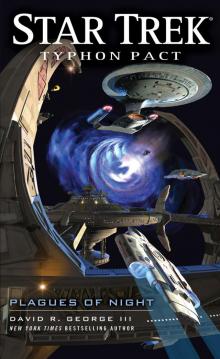 Star Trek: Typhon Pact 06: Plagues of Night
Star Trek: Typhon Pact 06: Plagues of Night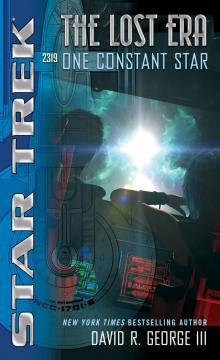 Star Trek: The Lost Era - 08 - 2319 - One Constant Star
Star Trek: The Lost Era - 08 - 2319 - One Constant Star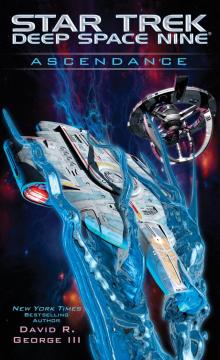 Star Trek: Deep Space Nine: Ascendance
Star Trek: Deep Space Nine: Ascendance Star Trek: TOS: Allegiance in Exile
Star Trek: TOS: Allegiance in Exile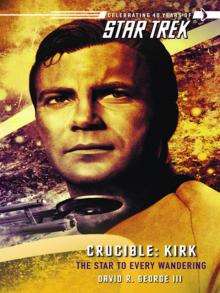 Crucible: Kirk
Crucible: Kirk Crucible: McCoy
Crucible: McCoy The Long Mirage
The Long Mirage Original Sin
Original Sin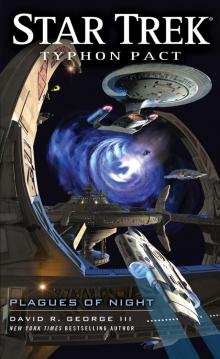 Star Trek: Typhon Pact: Plagues of Night
Star Trek: Typhon Pact: Plagues of Night Allegiance in Exile
Allegiance in Exile Sacraments of Fire
Sacraments of Fire Star Trek: Typhon Pact: Rough Beasts of Empire
Star Trek: Typhon Pact: Rough Beasts of Empire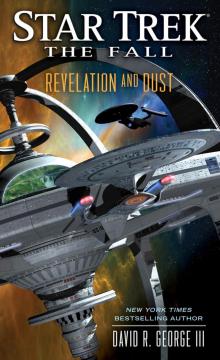 Star Trek: The Fall: Revelation and Dust
Star Trek: The Fall: Revelation and Dust